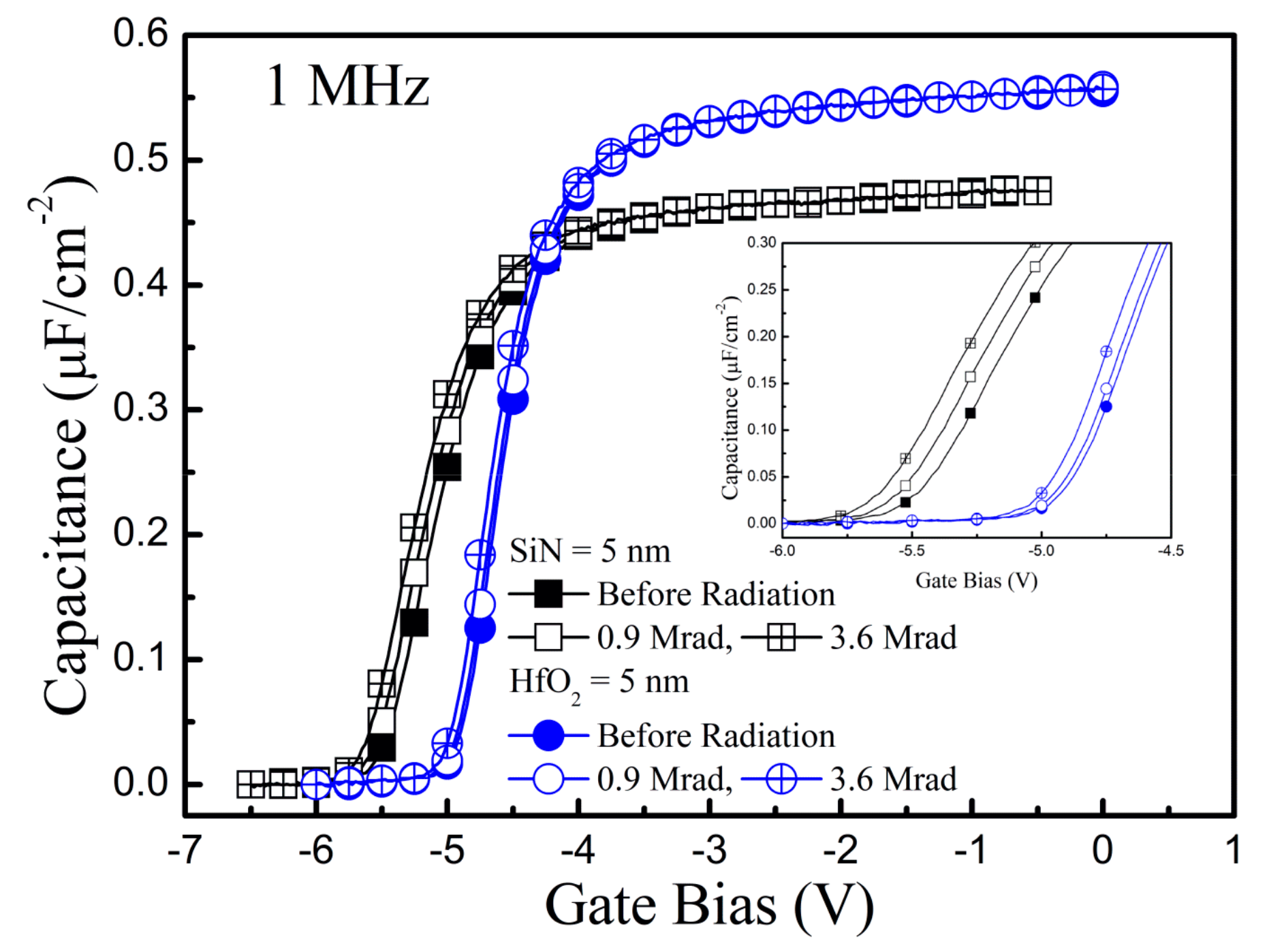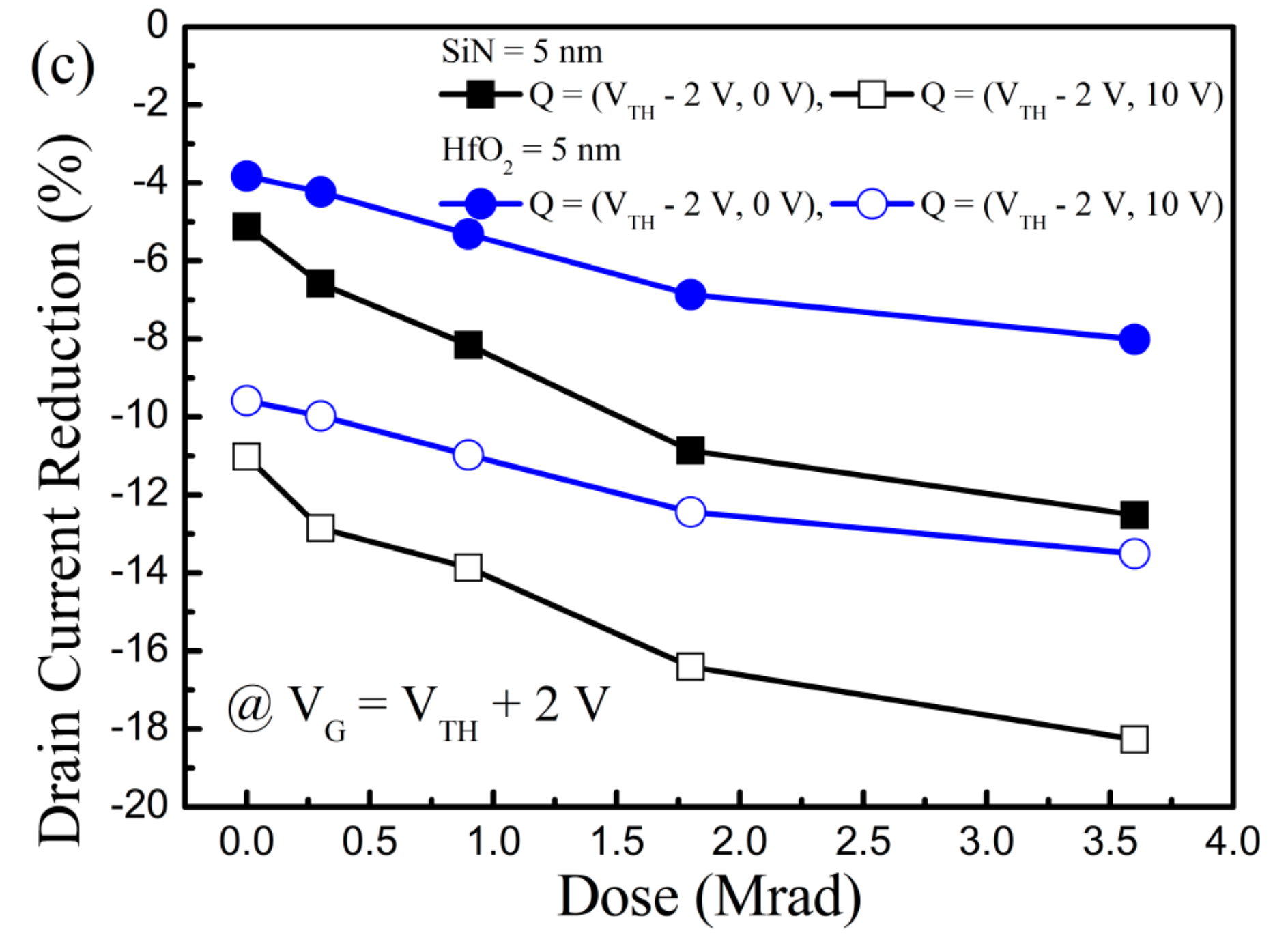Comprehensive Research of Total Ionizing Dose Effects in GaN-Based MIS-HEMTs Using Extremely Thin Gate Dielectric Layer
Abstract
:1. Introduction
2. Structure and Fabrication
3. Results and Discussion
4. Conclusions
Author Contributions
Funding
Conflicts of Interest
References
- Kumar, V.; Lu, W.; Schwindt, R.; Kuliev, A.; Simin, G.; Yang, J.; Khan, M.A.; Adesida, I. AlGaN/GaN HEMTs on SiC with f/sub T/ of over 120 GHz. IEEE Electron Device Lett. 2002, 23, 455–457. [Google Scholar] [CrossRef]
- Palacios, T.; Chakraborty, A.; Rajan, S.; Poblenz, C.; Keller, S.; DenBaars, S.P.; Speck, J.; Mishra, U.K. High-power AlGaN/GaN HEMTs for Ka-band applications. IEEE Electron Device Lett. 2005, 26, 781–783. [Google Scholar] [CrossRef] [Green Version]
- Green, B.; Chu, K.; Chumbes, E.; Smart, J.; Shealy, J.; Eastman, L.F. The effect of surface passivation on the microwave characteristics of undoped AlGaN/GaN HEMTs. IEEE Electron Device Lett. 2000, 21, 268–270. [Google Scholar] [CrossRef]
- Vetury, R.; Zhang, N.; Keller, S.; Mishra, U. The impact of surface states on the DC and RF characteristics of AlGaN/GaN HFETs. IEEE Trans. Electron Devices 2001, 48, 560–566. [Google Scholar] [CrossRef]
- Eastman, L.F.; Tilak, V.; Smart, J.; Green, B.M.; Chumbes, E.M.; Dimitrov, R.; Kim, H.; Ambacher, O.S.; Weimann, N.; Prunty, T.; et al. Undoped AlGaN/GaN HEMTs for microwave power amplification. IEEE Trans. Electron Devices 2001, 48, 479–485. [Google Scholar] [CrossRef]
- Hashizume, T.; Kotani, J.; Hasegawa, H. Leakage mechanism in GaN and AlGaN Schottky interfaces. Appl. Phys. Lett. 2004, 84, 4884. [Google Scholar] [CrossRef] [Green Version]
- Liu, Z.H.; Ng, G.I.; Arulkumaran, S.; Maung, Y.K.T.; Teo, K.L.; Foo, S.C.; Sahmuganathan, V. Improved tow-dimensional electron gas transport characteristics in AlGaN/GaN metal-insulator-semiconductor high electron mobility transistor with atomic layer-deposited Al2O3 as gate insulator. Appl. Phys. Lett. 2009, 95, 223501. [Google Scholar] [CrossRef]
- Ye, P.D.; Yang, B.; Ng, K.K.; Bude, J.; Wilk, G.D.; Halder, S.; Hwang, J.C.M. GaN metal-oxide-semiconductor high-electron-mobility-transistor with atomic layer deposited Al2O3 as gate dielectric. Appl. Phys. Lett. 2005, 86, 063501. [Google Scholar] [CrossRef] [Green Version]
- Khan, M.; Hu, X.; Sumin, G.; Lunev, A.; Yang, J.; Gaska, R.; Shur, M. AlGaN/GaN metal oxide semiconductor heterostructure field effect transistor. IEEE Electron Device Lett. 2000, 21, 63–65. [Google Scholar] [CrossRef]
- Chumbes, E.; Smart, J.; Prunty, T.; Shealy, J. Microwave performance of AlGaN/GaN metal insulator semiconductor field effect transistors on sapphire substrates. IEEE Trans. Electron Devices 2001, 48, 416–419. [Google Scholar] [CrossRef]
- Hashizume, T.; Anantathanasarn, S.; Negoro, N.; Sano, E.; Hasegawa, H.; Kumakura, K.; Makimoto, T. Al2O3 Insulated-Gate structure for AlGaN/GaN heterostructure field effect transistors having thin AlGaN barrier layers. Jpn. J. Appl. Phys. 2004, 43, L777–L779. [Google Scholar] [CrossRef] [Green Version]
- Lee, C.T.; Chen, H.W.; Lee, H.Y. Metal-oxide-semiconductor using Ga2O3 dielectrics on n-type GaN. Appl. Phys. Lett. 2003, 82, 4304. [Google Scholar] [CrossRef]
- Liu, C.; Chor, E.F.; Tan, L.S. Investigations of HfO2/AlGaN/GaN metal-oxide-semiconductor high electron mobility transistors. Appl. Phys. Lett. 2006, 88, 173504. [Google Scholar] [CrossRef]
- Mehandru, R.; Luo, B.; Kim, J.; Ren, F.; Gila, B.P.; Onstine, A.H.; Abernathy, C.R.; Pearton, S.J.; Gotthold, D.; Birkhahn, R.; et al. AlGaN/GaN metal-oxide-semoconductor high electron mobility transistors using Sc2O3 as the gate oxide and surface passivation. Appl. Phys. Lett. 2003, 82, 2530. [Google Scholar] [CrossRef]
- Balachander, K.; Arulkumaran, S.; Ishikawa, H.; Baskar, K.; Egawa, T. Studies on electron beam evaporated ZrO2/AlGaN/GaN metal-oxide-semiconductor high-electron-mobility transistors. Phys. Status Solidi 2005, 202, R16–R18. [Google Scholar] [CrossRef]
- Chang, S.J.; Jung, H.W.; Do, J.W.; Cho, K.J.; Kim, J.J.; Jang, Y.J.; Yoon, H.S.; Ahn, H.K.; Min, B.G.; Kim, H.; et al. Enhanced carrier transport properties in GaN-Based metal-insulator-semiconductor high electron mobility transistor with SiN/Al2O3Bi-layer passivation. ECS J. Solid State Sci. Technol. 2018, 7, N86–N90. [Google Scholar] [CrossRef]
- Anand, M.J.; Ng, G.I.; Vicknesh, S.; Arulkumaran, S.; Ranjan, K. Reduction of current collapse in AlGaN/GaN MISHEMT with bilayer SiN/Al2O3 dielectric gate stack. Phys. Status Solidi 2013, 10, 1421–1425. [Google Scholar]
- Keum, D.; Kim, H. Energy-dependent degradation characteristics of AlGaN/GaN MIS-HEMTs with 1, 1.5, and 2 MeV proton irradiation. ECS J. Solid State Sci. Technol. 2018, 7, Q159–Q163. [Google Scholar] [CrossRef]
- Sun, X.; Saadat, O.I.; Chen, J.; Zhang, E.X.; Cui, S.; Palacios, T.; Fleetwood, D.M.; Ma, T.P. Total-ionizing–dose effects in AlGaN/GaN HEMTs and MOS-HEMTs. IEEE Trans. Nucl. Sci. 2013, 60, 4074–4079. [Google Scholar] [CrossRef]
- Ahn, S.; Kim, B.J.; Lin, Y.H.; Ren, F.; Pearton, S.; Yang, G.; Kravchenko, I.I. Effect of proton irradiation dose on InAlN/GaN metal-oxide semiconductor high electron mobility transistors with Al2O3 gate oxide. J. Vac. Sci. Technol. B 2016, 34, 051202. [Google Scholar] [CrossRef]
- Bhuiyan, M.A.; Zhou, H.; Chang, S.J.; Lou, X.; Gong, X.; Jiang, R.; Gong, H.; Zhang, E.X.; Won, C.; Lim, J.W.; et al. Total-Ionizing-Dose responses of GaN-Based HEMTs with different channel thicknesses and MOSHEMTs with epitaxial MgCaO as gate dielectric. IEEE Trans. Nucl. Sci. 2018, 65, 46–52. [Google Scholar] [CrossRef]
- Gao, Z.; Romero, M.F.; Redondo-Cubero, A.; Pampillon, M.A.; Andrés, E.S.; Calle, F. Effects of Gd2O3 Gate dielectric on proton-irradiated AlGaN/GaN HEMTs. IEEE Electron Device Lett. 2017, 38, 611–614. [Google Scholar] [CrossRef]
- Chang, S.J.; Cho, K.J.; Jung, H.W.; Kim, J.J.; Jang, Y.J.; Bae, S.B.; Kim, D.S.; Bae, Y.; Yoon, H.S.; Ahn, H.K.; et al. Improvement of proton radiation hardness using ALD-Deposited Al2O3 gate insulator in GaN-Based MIS-HEMTs. ECS J. Solid State Sci. Technol. 2019, 8, Q245–Q248. [Google Scholar] [CrossRef]
- Aktas, O.; Kuliev, A.; Kumar, V.; Schwindt, R.; Toshkov, S.; Costescu, D.; Stubbins, J.; Adesida, I. 60Co gamma radiation effects on DC, RF, and pulsed I–V characteristics of AlGaN/GaN HEMTs. Solid-State Electron. 2004, 48, 471–475. [Google Scholar] [CrossRef]
- Kaya, S.; Yildiz, I.; Lok, R.; Yilmaz, E. Co-60 gamma irradiation influences on physical, chemical and electrical characteristics of HfO2/Si thin films. Radiat. Phys. Chem. 2018, 150, 64–70. [Google Scholar] [CrossRef]
- Suria, A.J.; Chiamori, H.C.; Shankar, A.; Senesky, D.G. Capacitance-voltage characteristics of gamma irradiated Al2O3, HfO2, and SiO2 thin films grown by plasma-enhanced atomic layer deposition. In Sensors for Extreme Harsh Environments II, Proceedings of SPIE Vol.; Senesky, D.G., Dekate, S., Eds.; 9491, Baltimore, MD, USA, 20–24 April 2015; Senesky, D.G., Dekate, S., Eds.; SPIE: Bellingham, WA, USA, 2015, p. 949105. [Google Scholar]
- Chang, S.J.; Bhuiyan, M.A.; Won, C.H.; Lee, J.H.; Jung, H.W.; Shin, M.J.; Lim, J.W.; Ma, T.P. Dependence of GaN channel thickness on the transistor characteristics of AlGaN/GaN HEMTs grown on sapphire. ECS J. Solid State Sci. Technol. 2016, 5, N102–N107. [Google Scholar] [CrossRef]
- Krick, D.T.; Lenahan, P.M.; Kanicki, J. Nature of the dominant deep trap in amorphous silicon nitride. Phys. Rev. B 1988, 38, 8226–8229. [Google Scholar] [CrossRef]
- Hezel, R.; Schorner, R. Plasma Si nitride–A promising dielectric to achieve high-quality silicon MIS-IL solar cells. J. Appl. Phys. 1981, 52, 3076–3079. [Google Scholar] [CrossRef]
- Sharma, V.; Tracy, C.J.; Schroder, D.K.; Herasimenka, S.; Dauksher, W.J.; Bowden, S. Manipulation of K center charge states in silicon nitride films to achieve excellent surface passivation for silicon solar cells. Appl. Phys. Lett. 2014, 104, 053503. [Google Scholar] [CrossRef]
- Dong, P.; Yu, X.; Ma, Y.; Xie, M.; Li, Y.; Huang, C.; Li, M.; Dai, G.; Zhang, J. A deep-level transit spectroscopy study of gamma-ray irradiation on the passivation properties of silicon nitride layer on silicon. AIP Adv. 2017, 7, 085112. [Google Scholar] [CrossRef] [Green Version]
- Chang, S.J.; Kang, H.S.; Lee, J.H.; Yang, J.; Bhuiyan, M.; Jo, Y.W.; Cui, S.; Lee, J.H.; Ma, T.P. Investigation of channel mobility in AlGaN/GaN high-electron-mobility transistors. Jpn. J. Appl. Phys. 2016, 55, 44104. [Google Scholar] [CrossRef]








Publisher’s Note: MDPI stays neutral with regard to jurisdictional claims in published maps and institutional affiliations. |
© 2020 by the authors. Licensee MDPI, Basel, Switzerland. This article is an open access article distributed under the terms and conditions of the Creative Commons Attribution (CC BY) license (http://creativecommons.org/licenses/by/4.0/).
Share and Cite
Chang, S.-J.; Kim, D.-S.; Kim, T.-W.; Lee, J.-H.; Bae, Y.; Jung, H.-W.; Kang, S.C.; Kim, H.; Noh, Y.-S.; Lee, S.-H.; et al. Comprehensive Research of Total Ionizing Dose Effects in GaN-Based MIS-HEMTs Using Extremely Thin Gate Dielectric Layer. Nanomaterials 2020, 10, 2175. https://doi.org/10.3390/nano10112175
Chang S-J, Kim D-S, Kim T-W, Lee J-H, Bae Y, Jung H-W, Kang SC, Kim H, Noh Y-S, Lee S-H, et al. Comprehensive Research of Total Ionizing Dose Effects in GaN-Based MIS-HEMTs Using Extremely Thin Gate Dielectric Layer. Nanomaterials. 2020; 10(11):2175. https://doi.org/10.3390/nano10112175
Chicago/Turabian StyleChang, Sung-Jae, Dong-Seok Kim, Tae-Woo Kim, Jung-Hee Lee, Youngho Bae, Hyun-Wook Jung, Soo Cheol Kang, Haecheon Kim, Youn-Sub Noh, Sang-Heung Lee, and et al. 2020. "Comprehensive Research of Total Ionizing Dose Effects in GaN-Based MIS-HEMTs Using Extremely Thin Gate Dielectric Layer" Nanomaterials 10, no. 11: 2175. https://doi.org/10.3390/nano10112175
APA StyleChang, S.-J., Kim, D.-S., Kim, T.-W., Lee, J.-H., Bae, Y., Jung, H.-W., Kang, S. C., Kim, H., Noh, Y.-S., Lee, S.-H., Kim, S.-I., Ahn, H.-K., & Lim, J.-W. (2020). Comprehensive Research of Total Ionizing Dose Effects in GaN-Based MIS-HEMTs Using Extremely Thin Gate Dielectric Layer. Nanomaterials, 10(11), 2175. https://doi.org/10.3390/nano10112175




